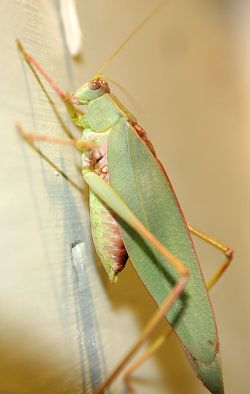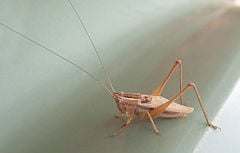Ensifera
| Ensifera
| ||||||||||
|---|---|---|---|---|---|---|---|---|---|---|
 Katydid
| ||||||||||
| Scientific classification | ||||||||||
| ||||||||||
|
Ensifera is a suborder of the order Orthoptera, comprising "longhorned" orthopterans commonly known as crickets, katydids and bush crickets and characterized in extant members by long, fine, and threadlike antennae that have well over 30 segments and can reach several times the body length.
weta
katydids (or bush-crickets)
true crickets
weta
comprising "longhorned" orthopterans characterized by long, threadlike antennae in extant species
insects commonly known as crickets, katydids and bush crickets. "Ensifer" means "sword bearer" in Latin, and refers to the typically elongated and blade-like ovipositor of the females. The classification of the suborder was drastically revised in December 2005 by the Orthopterists' Society.
Tettigoniidae' is a major family of "long-horned grasshoppers" in the suborder Ensifera of the order Orthoptera, characterized by strong hind limbs for leaping, powerful mouth-parts for chewing, four tarsal segments, long and threadlike antennae (which have well over 30 segments and may exceed their own body length), stidulatory specializations of the forewings to make sounds, and a left over right overlap of the singing wings in males. Members of Tettigoniidae are known by the common name of katydids in the New World, Australia, and New Zealand, and bushcrickets in Europe, while the term long-horned grasshoppers also is used in some locations (sometimes in Australia and New Zealand as well), but sometimes also applies to members of Ensifera in general. Tettigoniids are closely related to the crickets of the same Ensifera suborder.
Overview
As member of the insect order Orthoptera (grasshoppers, crickets, katydids, and locusts), tettigoniids are characterized by chewing/biting mouthparts, incomplete metamorphosis (hemimetabolism), and two pairs of wings that are held overlapping the abdomen at rest. As with the other orthopterans, the the forewings are narrower than the hindwings and hardened at the base, while the hindwings are membranous and folded fan-like under the forewings when at rest.
As members of the suborder Ensifera, which also includes crickets, the tettigoniids are characterized by fine and threadlike antennae with well over 30 segments (except fossil representatives), stidulatory specializations of the forewings to make sounds, auditory organs (when present) linked via modified tracheae to the enlarged mesothoracic spiracles, a sword-like or needle-like six-valved ovipositor (when present), and elongate mandibles with a prominent incisor (Gwynne and Desutter 1996).
ReferencesISBN links support NWE through referral fees
- Gwynne, D. T. and G. K. Morris. 2002. Tettigoniidae. Katydids, Long-horned grasshoppers and bushcrickets. Tree of Life Web Project Version 26 November 2002. Retrieved November 10, 2008.
- Gwynne, D. T. and L. DeSutter. 1996. Ensifera. Crickets, katydids and weta. Tree of Life Web Project Version 01 January 1996. Retrieved November 10, 2008.
- Gwynne, D. T., L. DeSutter, P. Flook, and H. Rowell. 1996. Orthoptera. Crickets, kaytdids, grasshoppers, etc.. Tree of Life Web Project Version 01 January 1996. Retrieved November 10, 2008.
External links
Credits
New World Encyclopedia writers and editors rewrote and completed the Wikipedia article in accordance with New World Encyclopedia standards. This article abides by terms of the Creative Commons CC-by-sa 3.0 License (CC-by-sa), which may be used and disseminated with proper attribution. Credit is due under the terms of this license that can reference both the New World Encyclopedia contributors and the selfless volunteer contributors of the Wikimedia Foundation. To cite this article click here for a list of acceptable citing formats.The history of earlier contributions by wikipedians is accessible to researchers here:
The history of this article since it was imported to New World Encyclopedia:
Note: Some restrictions may apply to use of individual images which are separately licensed.
